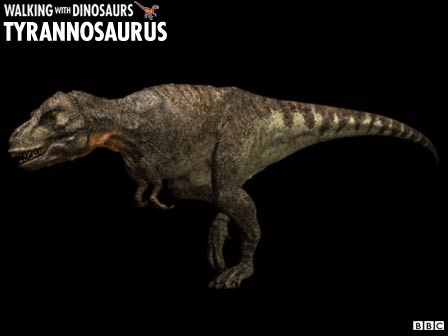| Tyrannosaurus | |
|---|---|
 | |
|
Kingdom: |
Animalia |
|
Phylum: |
Chordata |
|
Class: |
Reptilia |
|
Superorder: |
Dinosauria |
|
Order: |
Saurischia |
|
Suborder: |
Theropoda |
|
Superfamily: |
|
|
Family: |
|
|
Genus: |
†Tyrannosaurus |
|
Species: |
†T. rex (type) |
Perhaps the most famous and iconic dinosaur, Tyrannosaurus was a large genus of theropod from the Maastrichtian Stage of the Late Cretaceous. Originally discovered in the Hell Creek Formation in Montana, Tyrannosaurus is known to have been widespread in the Western United States. This massive dinosaur measured over 12 meters (39 feet) long. One specimen, nicknamed "Sue" measured 12.8 meters (42 feet) from nose to tail. Although a very large genus, Spinosaurus and Giganotosaurus were both larger.
Description[]
Tyrannosaurus is easily distinguished by its enormous head with a powerful set of jaws containing 58 serrated teeth. These teeth measured up to 15 cm (6 in) long, some of the largest teeth known. Backed by powerful muscles, Tyrannosaurus' jaws would have been capable of delivering a bone crunching bite, tearing as much as 90.7 kgs (200 lbs) of flesh in the process. To balance such a formidable head, Tyrannosaurus' forelimbs dwindled to tiny, but not quite vestigial arms. These arms had muscles 3.3 times a strong as human arm muscles and may have helped with copulating in some way. They also may have just been vestigial. Unusual to theropods, Tyrannosaurus had only two functional fingers, topped off with curved claws, whereas most theropods have three-fingered arms. A third vestigial finger, greatly reduced is also present To further balance such a bulk, Tyrannosaurus would have had to have held its vertebrae in a horizontal posture, with its tail erect out behind it. Some of Tyrannosaurus' back vertebrae had holes in oder to lighten the massive body, similarly to bird bones.
Locomotion[]
Tyrannosaurus locomotion techniques have long been speculated. The legs of Tyrannosaurus show considerable amounts of muscle suggesting a great amount of power could be put in to each stride. Scientist have suggest speeds from 40 km/h (25 mph) to 45 mph However, Tyrannosaurus' large bulk must be taken into account. Computer simulations of different speeds show that speeds over 40 km/h (25 mph) are unfeasible for to obtain greater speeds, the legs, to support the dino's mass, would have to be 88% the total mass.
Hunting or Scavenging?[]
Hunting[]
Whether T. rex was an active hunter or a scavenger has been a subject of much debate. Its eye sockets faced forward, suggesting it had keen binocular vision, a trait associated with active predators. An Edmontosaurus specimen has been uncovered and described with healed tooth-inflicted damage on its tail vertebrae, that can be attributed to a Tyrannosaurus. The damage appeared to have healed, which suggests that the Edmontosaurus must have survived an attempted predation on a living organism. Tooth marks on a Triceratops squamosal (frill) and horn suggest yet another active predation attempt.
Scavenging[]
Based on the fact Tyrannosaurus couldn't have run very fast and supported its own weight, some scientist argue Tyrannosaurus was a scavenger. They also say that the the powerful jaws would have been ideal for crunching through bones, thereby, extracting marrow. The keen sense of smell Tyrannosaurus possessed would have helped sniffed out a carcass from afar. Being the largest carnivore in the area, T. rex could easily scare away other scavengers. It is possible that Tyrannosaurus was an active hunter when the food supply was abundant and a capable scavenger when times were hard for hunting.
Classification[]
Tyrannosaurus has been classified into a family of theropods called the Tyrannosauridae, and further into the Superfamily Tyrannosauroidea. Tyrannosaurus is the type genus meaning it is a standard for all tyrannosaurids.








